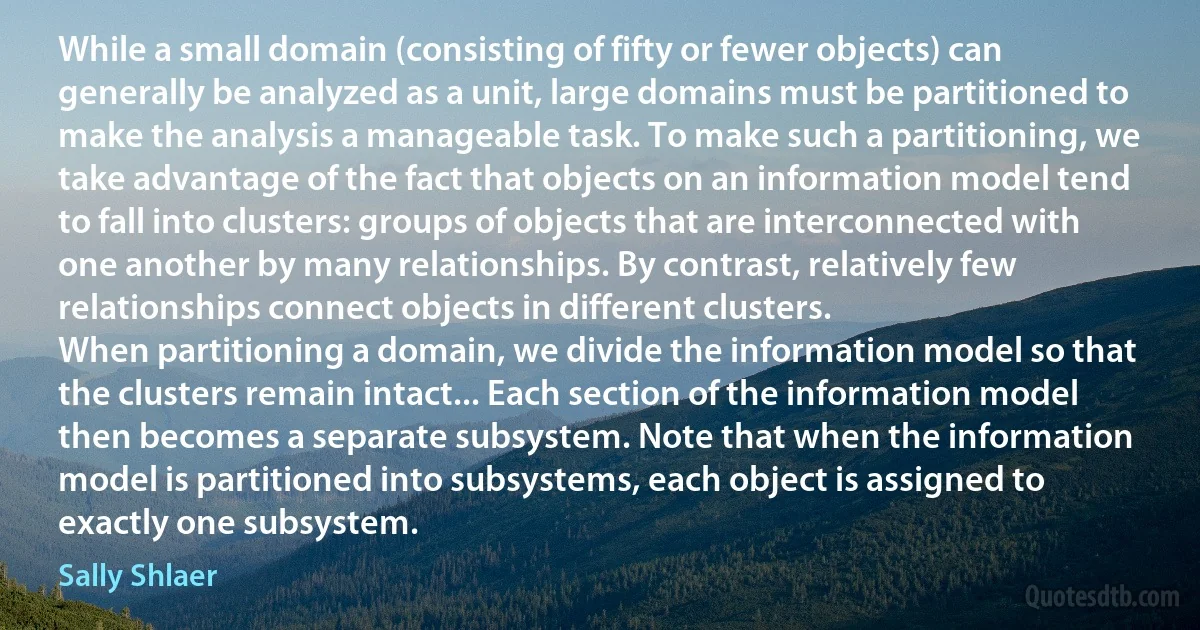
While a small domain (consisting of fifty or fewer objects) can generally be analyzed as a unit, large domains must be partitioned to make the analysis a manageable task. To make such a partitioning, we take advantage of the fact that objects on an information model tend to fall into clusters: groups of objects that are interconnected with one another by many relationships. By contrast, relatively few relationships connect objects in different clusters. When partitioning a domain, we divide the information model so that the clusters remain intact... Each section of the information model then becomes a separate subsystem. Note that when the information model is partitioned into subsystems, each object is assigned to exactly one subsystem.
Sally ShlaerRelated topics
advantage connect contrast different divide fall few fifty large model note remain small take task unit whileRelated quotes
As Ralph Ellison wrote more than 35 years ago, 'Why is it so often true that when critics confront the American as Negro, they suddenly drop their advanced critical armament and revert with an air of confident superiority to quite primitive modes of analysis?' Those matters accomplished by whites are routinely subjected to sophisticated modes of analysis. But the when the selfsame matters are accomplished by blacks, the opaque racial prism of analysis precludes such sophistication, and all is seen in black and white. And some who would not venture onto the more sophisticated analytical turf are quite content to play in the minor leagues of primitive harping. The more things change, the more they remain the same.

Clarence Thomas
No former age was ever in such a favorable position with regard to the sources of our knowledge of human nature. Psychology, ethnology, anthropology, and history have amassed an astonishingly rich and constantly increasing body of facts. Our technical instruments for observation and experimentation have been immensely improved, and our analyses have become sharper and more penetrating. We appear, nevertheless, not yet to have found a method for the mastery and organization of this material.... Unless we succeed in finding a clue of Ariadne to lead us out of this labyrinth, we can have no real insight into the general character of human culture; we shall remain lost in a mass of disconnected and disintegrated data which seem to lack all conceptual unity.

Ernst Cassirer
I have invented [c. 1915-1916] a new series of verses, verses without words, or sound poems, in which the balancing of the vowels is gauged and distributed according to the value of the initial line... With these sound poems we should renounce language, devastated and made impossible by journalism. We should withdraw into the innermost alchemy of the word, and even surrender the word, thus conserving for poetry its most sacred domain. We should refuse to make poems second-hand; we should stop taking over words (not to mention sentences) which we did not invent entirely anew for our own use. We should no longer be content to achieve poetic effects which, in the final analysis, are but echoes of inspiration..

Hugo Ball
The most promising lines of development of theory in the sociological and most immediately related fields, particularly the psychological and cultural, therefore, seem to be two-fold. One major direction is the theoretical elaboration and refinement of structural-functional analysis of social systems, including the relevant problems of motivation and their relation to cultural patterns. In this process, the structure of social action provides a basic frame of reference, and aspects of it become of direct substantive importance at many specific points. The main theoretical task, however, is more than a refinement of the conceptual scheme of the presently reprinted book - it involves transition and translation to a different level and focus of theoretical systematization.

Talcott Parsons
What this book is about is a kind of analysis that is characteristic of a large part of the social sciences, especially the more theoretical part. That kind of analysis explores the relation between the behavior of individuals who compromise some social aggregate, and the characteristics of the aggregate.These situations, in which people's behavior or people's choices depend on the behavior or choices of other people, are the ones that usually don't permit any simple summation or extrapolation of the aggregates. To make that connection we usually have to look at the system of interaction between individuals and their environment, that is, between individuals and other individuals or between individuals and the collectivity.

Thomas Schelling
